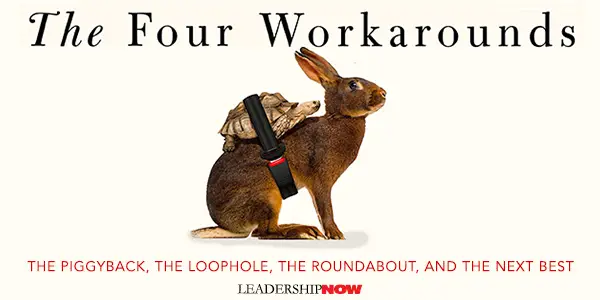 |
 |
04.25.23

The Four Workarounds
WORKAROUNDS are a deviation from the norm. They are nonconformity. Conformity isn’t all bad; we often do it without much thought. But there are times when we are better served when we ask why and perhaps deviate from the expected. Oxford University professor Paulo Savaget makes a distinction between disobedience and deviance in The Four Workarounds: Strategies from the World's Scrappiest Organizations for Tackling Complex Problems. He says that disobedience isn’t the opposite of conformity. “Disobedience blatantly antagonizes the establishment, and the establishment almost always retaliates in kind. Deviance, on the other hand, is trickier. Deviance entails unconventional approaches that use parts of the status quo that work (as intended or not) in order to change the parts that don’t.” Deviance is the opposite of conformity. Savaget identifies three approaches to deviance or standing out from the crowd. First, there’s confrontation which “always means clashes against dominant power structures.” Second, there’s negotiation to put pressure “on authority figures to legitimize changes in the system of rules.” And finally, there’s the workaround. “Through workarounds, we can promptly get things done and defy the status quo without directly antagonizing rule enforcers.” Workarounds are the lower-risk option for moving something along. There are four workarounds each using a different attribute. Knowing each approach can help you determine the best response to getting things done. The Piggyback “The piggyback workaround enables us to circumvent all sorts of obstacles and address our problems by using seemingly unrelated relationships.” The piggyback often creates relationships between unconventional partners. Piggybacks occur “between silos rather than in them.” A couple solved a problem of distributing life-saving medicines in Sub-Saharan Africa by piggybacking on the distribution of Coca-Cola that was readily available in the region. Oreo piggybacked clever Twitter advertising on the 2013 Super Bowl power outage. The Loophole “The loophole either capitalizes on an ambiguity or uses an unconventional set of rules when they aren’t the most obviously applicable.” In looking for loopholes, remember that “there’s often more than one way to be right, and simply following or breaking rules isn’t always the best way to get something done. Often there is an option that lies in between.” The Roundabout A roundabout may not solve the problem, but it can buy us time until we can find a permanent solution. It can be useful if you use that time wisely. “Roundabouts don’t so much tackle systemic challenges as interrupt self-reinforcing behaviors and but time to mobilize, negotiate, and develop alternatives, alleviating an urgent problem while building momentum to pivot in a different direction.” The Next Best Next-best workarounds use what is available to solve an immediate goal. “Using limited resources, scrappy organizations and mavericks teach us that often the best step forward is not focusing on what the ideal ought to be, but instead drawing attention to available opportunities that tend to be ignored.” A great example of a next-best workaround is the non-profit Rainforest Connection to thwart illegal logging. By repurposing old cell phones strategically placed in the rainforest to listen for the sound of chainsaws, they are able to send real-time alerts to rangers and community patrols with the location of the logging to catch loggers in the act. Each of the workarounds has a primary element at play. When you think about piggybacks, consider the existing relationships in your situation. Loopholes require paying close attention to different sets of rules. Roundabouts involve examining behaviors that lead to inertia. And if you’re searching for next-best approaches, fiddle with the resources you have on hand. Not every situation is going to necessitate using each of these four workarounds, and that’s okay. In the end, you really only need one workaround for most challenges. 
Posted by Michael McKinney at 07:20 PM
|
BUILD YOUR KNOWLEDGE
 

How to Do Your Start-Up Right STRAIGHT TALK FOR START-UPS 
Grow Your Leadership Skills NEW AND UPCOMING LEADERSHIP BOOKS 
Leadership Minute BITE-SIZE CONCEPTS YOU CAN CHEW ON 
Classic Leadership Books BOOKS TO READ BEFORE YOU LEAD |